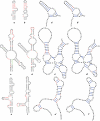Diversity of 16S rRNA genes within individual prokaryotic genomes
- PMID: 20418441
- PMCID: PMC2893482
- DOI: 10.1128/AEM.02953-09
Diversity of 16S rRNA genes within individual prokaryotic genomes
Erratum in
- Appl Environ Microbiol. 2010 Aug;76(15):5333
Abstract
Analysis of intragenomic variation of 16S rRNA genes is a unique approach to examining the concept of ribosomal constraints on rRNA genes; the degree of variation is an important parameter to consider for estimation of the diversity of a complex microbiome in the recently initiated Human Microbiome Project (http://nihroadmap.nih.gov/hmp). The current GenBank database has a collection of 883 prokaryotic genomes representing 568 unique species, of which 425 species contained 2 to 15 copies of 16S rRNA genes per genome (2.22 +/- 0.81). Sequence diversity among the 16S rRNA genes in a genome was found in 235 species (from 0.06% to 20.38%; 0.55% +/- 1.46%). Compared with the 16S rRNA-based threshold for operational definition of species (1 to 1.3% diversity), the diversity was borderline (between 1% and 1.3%) in 10 species and >1.3% in 14 species. The diversified 16S rRNA genes in Haloarcula marismortui (diversity, 5.63%) and Thermoanaerobacter tengcongensis (6.70%) were highly conserved at the 2 degrees structure level, while the diversified gene in B. afzelii (20.38%) appears to be a pseudogene. The diversified genes in the remaining 21 species were also conserved, except for a truncated 16S rRNA gene in "Candidatus Protochlamydia amoebophila." Thus, this survey of intragenomic diversity of 16S rRNA genes provides strong evidence supporting the theory of ribosomal constraint. Taxonomic classification using the 16S rRNA-based operational threshold could misclassify a number of species into more than one species, leading to an overestimation of the diversity of a complex microbiome. This phenomenon is especially seen in 7 bacterial species associated with the human microbiome or diseases.
Figures




References
-
- Abdulkarim, F., and D. Hughes. 1996. Homologous recombination between the tuf genes of Salmonella typhimurium. J. Mol. Biol. 260:506-522. - PubMed
-
- Arbique, J. C., C. Poyart, P. Trieu-Cuot, G. Quesne, M. da Glória, S. Carvalho, A. G. Steigerwalt, R. E. Morey, D. Jackson, R. J. Davidson, and R. R. Facklam. 2004. Accuracy of phenotypic and genotypic testing for identification of Streptococcus pneumoniae and a description of Streptococcus pseudopneumoniae sp. nov. J. Clin. Microbiol. 42:4686-4696. - PMC - PubMed
Publication types
MeSH terms
Substances
Grants and funding
LinkOut - more resources
Full Text Sources
Other Literature Sources

